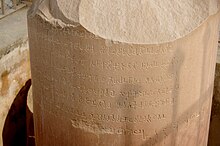Brahmi script
| Brahmi |
|
|---|---|

Brahmi script on Ashoka Pillar
|
|
| Type | |
| Languages | Middle Indo-Aryan (Prakrit) languages, Dravidian languages (Tamil et al.), Saka, |
|
Time period
|
3rd century BCE to 5th century CE |
|
Parent systems
|
|
|
Child systems
|
Gupta, Pallava alphabet, and numerous descendant writing systems |
|
Sister systems
|
Kharosthi |
| Direction | Left-to-right |
| ISO 15924 | Brah, 300 |
|
Unicode alias
|
Brahmi |
| U+11000–U+1107F | |
Brahmi (brāhmī) is the modern name given to one of the oldest writing systems used in South and Central Asia during the final centuries BCE and the early centuries CE. Like its contemporary Kharosthi, which was used in what is now Afghanistan and Pakistan, it is an abugida.
The best-known Brahmi inscriptions are the rock-cut edicts of Ashoka in north-central India, dating to 250–232 BCE. The script was deciphered in 1837 by James Prinsep, an archaeologist, philologist, and official of the East India Company. The origin of the script is still much debated, with most scholars concurring that Brahmi was derived from or at least influenced by one or more contemporary Semitic scripts, while others favoring the idea of an indigenous origin or connected to the much older and as-yet undeciphered Indus script.
Brahmi was at one time referred to in English as the "pin-man" script, that is "stick figure" script. It was known by a variety of other names until the 1880s when Albert Étienne Jean Baptiste Terrien de Lacouperie, based on an observation by Gabriel Devéria, associated it with the Brahmi script, the first in a list of scripts mentioned in the Lalitavistara Sūtra. Thence the name was adopted in the influential work of Georg Bühler, albeit in the variant form "Brahma". The Gupta script of the 5th century is sometimes called "Late Brahmi".
The Brahmi script diversified into numerous local variants, classified together as the Brahmic scripts. Dozens of modern scripts used across South Asia have descended from Brahmi, making it one of the world's most influential writing traditions. One survey found 198 scripts that ultimately derive from it.
...
Wikipedia
